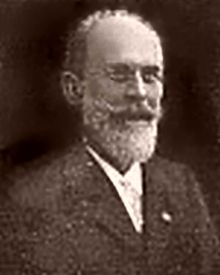
Bernhard Adalbert Emil Koehne (12 February 1848 – 12 October 1918) was a German botanist and dendrologist born near Striegau, a town known today as Strzegom, Poland.
Koehne was a professor of botany in Berlin and was a leading authority of the plant family Lythraceae. In Adolf Engler's treatise Das Pflanzenreich ("The Plant Kingdom"), he was author of the chapter on Lythraceae. He also made important contributions involving Lythraceae to Engler and Karl Prantl's Die Natürlichen Pflanzenfamilien ("The Natural Plant Families"), as well as to Karl Friedrich Philipp von Martius' Flora Brasiliensis.
Another noted written effort by Koehne was the 1893 Deutsche Dendrologie ("German Dendrology").
Two plant genera have been named in his honor; Koehneola from Cuba, in the (family Asteraceae) was named in 1901,[1] and Koehneria from Madagascar, in the family Lythraceae in 1987.[2]
Koehne edited and distributed the exsiccata Herbarium dendrologicum adumbrationibus illustratum.[3]
References
[edit]- Robert Zander, Fritz Encke, Günther Buchheim, Siegmund Seybold (eds.): Handbook of Plant Names 13th Edition. Ulmer Verlag, Stuttgart 1984, ISBN 3-8001-5042-5
- ^ "Koehneola Urb. | Plants of the World Online | Kew Science". Plants of the World Online. Retrieved 10 October 2021.
- ^ "Koehneria S.A.Graham, Tobe & Baas | Plants of the World Online | Kew Science". Plants of the World Online. Retrieved 27 May 2021.
- ^ "Herbarium dendrologicum adumbrationibus illustratum: IndExs ExsiccataID=117990272". IndExs – Index of Exsiccatae. Botanische Staatssammlung München. Retrieved 11 August 2024.
- ^ International Plant Names Index. Koehne.
External links
[edit]- IPNI List of plants described and co-described by Koehne.
Well, that’s interesting to know that Psilotum nudum are known as whisk ferns. Psilotum nudum is the commoner species of the two. While the P. flaccidum is a rare species and is found in the tropical islands. Both the species are usually epiphytic in habit and grow upon tree ferns. These species may also be terrestrial and grow in humus or in the crevices of the rocks.
View the detailed Guide of Psilotum nudum: Detailed Study Of Psilotum Nudum (Whisk Fern), Classification, Anatomy, Reproduction